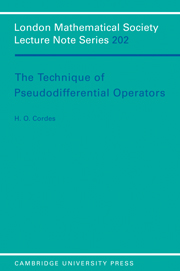Book contents
- Frontmatter
- Contents
- Preface
- Chapter 0 Introductory discussions
- Chapter 1 Calculus of pseudodifferential operators
- Chapter 2 Elliptic operators and parametrices in ℝn
- Chapter 3 L2-Sobolev theory and applications
- Chapter 4 Pseudodifferential operators on manifolds with conical ends
- Chapter 5 Elliptic and paraolic problems
- Chapter 6 Hyperbolic first order systems
- Chapter 7 Hyperbolic differential equations
- Chapter 8 Pseudodifferential operators as smooth operators of L(H)
- Chapter 9 Particle flow and invariant algebra of a semi-strictly hyperbolic system; coordinate invariance of Opψxm.
- Chapter 10 The invariant algebra of the Dirac equation
- References
- Index
Chapter 8 - Pseudodifferential operators as smooth operators of L(H)
Published online by Cambridge University Press: 09 February 2010
- Frontmatter
- Contents
- Preface
- Chapter 0 Introductory discussions
- Chapter 1 Calculus of pseudodifferential operators
- Chapter 2 Elliptic operators and parametrices in ℝn
- Chapter 3 L2-Sobolev theory and applications
- Chapter 4 Pseudodifferential operators on manifolds with conical ends
- Chapter 5 Elliptic and paraolic problems
- Chapter 6 Hyperbolic first order systems
- Chapter 7 Hyperbolic differential equations
- Chapter 8 Pseudodifferential operators as smooth operators of L(H)
- Chapter 9 Particle flow and invariant algebra of a semi-strictly hyperbolic system; coordinate invariance of Opψxm.
- Chapter 10 The invariant algebra of the Dirac equation
- References
- Index
Summary
Introduction
In this chapter we look at a different way to introduce pseudodifferential operators. From their introduction in ch.I – using 1,(1.5)- they appear as a technical device inspired by the Fourier- Laplace method. It may be surprising that there is a natural definition of ψdo's at least for some special symbol classes: Certain algebras of ψdo's appear as “smooth” subalgebras of L(H). For example, the algebra OpCB∞(ℝ2n), with CB∞ (ℝ2n) = ψt0 the class of a(x,ξ) ∈ C∞(ℝ2n), bounded with all derivatives, coincides with the class of operators A∈ L(H) which are both “translation smooth” and “gauge smooth”. That is, with the family {Tz:z∈ ℝn} of translation operators Tz u(x)=u(x−z), and the family {Mζ :ξ∈ℝn} of “gauge multiplications” Mζu(x)=eiζx u(x), we get T-zATz∈ C∞ (ℝn,L(H)) and M_ζAMζ∈ C(ℝn, L(H)). Notice that both Tz and Mζ are groups of unitary operators on H, representations of the Lie-group ℝn in U(H).
In terms of ch.I, OpΨt0=OpCB∞ (ℝ2n), a subalgebra of L(H</i
>) by III,1, is the class of translation and gauge smooth operators.
There are other natural actions of Lie groups on H=L2 (ℝn), such as the dilations u(x)→u(γx), with γ≠0, or the rotations u(x)→u(ox), with a rotation o:ℝn→ℝn, or the linear group u(x)→u(mx) with a nonsingular real matrix jn. If we require dilation and rotation smoothness, in addition to translation and gauge smoothness we obtain a more practical algebra (called Opψ⊆0) with a calculus of ψdo's and symbol decay similar to Opψ⊆0.
- Type
- Chapter
- Information
- The Technique of Pseudodifferential Operators , pp. 247 - 281Publisher: Cambridge University PressPrint publication year: 1995



